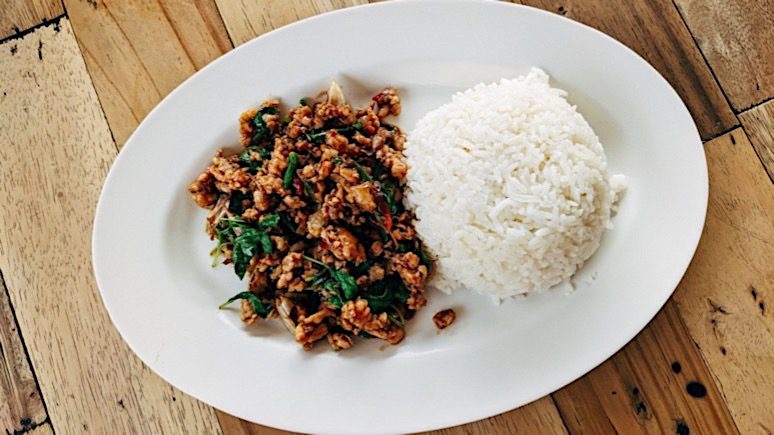Introduction
The vertical diet was created to contribute to muscle mass gaining and enhancing performance for athletes, bodybuilders, powerlifters, as well as common gym-goers. This eating program encourages consuming primarily red meat and white rice along with other easily digestible products to boost the intake of carbohydrates and proteins. The diet was invented by Stan Efferding, a powerlifter. In contrast to classic diets that encourage diverse food groups, the vertical eating plan promotes the consumption of a limited number of high-quality, nutrient-dense products.
The vertical diet aims at weight loss, muscle mass gaining, improvement of gut health, boosting energy and endurance, elevating production of testosterone, as well as faster recovery of athletes.
Key points
In the vertical eating program, the primary products are white rice and red meat. According to the creator of this eating program, white rice is easy to digest, so it serves as a primary source of carbohydrates. It is essential for athletes with very high-calorie requirements. In turn, red meat is higher in nutrient density and composition of zinc, iron, cholesterol, and B-group vitamins than poultry and fish. It is important for testosterone production and boosting muscle growth. Therefore, red meat is in preference among the followers of the vertical diet.
Nevertheless, it is impossible to meet all body’s micronutrient requirements if you eat only white rice and red meat. Thus, the vertical eating program also includes limited quantities of easily digestible, nutrient-dense products like salmon, yogurt, eggs, and spinach.
The verticle diet excludes all products that are not easy to digest. Restricted foods include brown rice, legumes, and other grains since they have phytic acid and lectins in their composition. These components may reduce your absorption of specific nutrients. In addition, you need to refuse to eat vegetables that may induce bloating. Such vegetables include cauliflower, cabbage, broccoli, kale, and other high-FODMAP products, along with garlic and onion.
You can have small amounts of oats or legumes as long as they are soaked or sprouted to ease their digestion and absorption.
The diet is designed to be significant in carbs. Nevertheless, it can also be adjusted to suit low-carb diets, paleo diets, and intermittent fasting.
Contraindications
People with cardiovascular diseases have to avoid following a vertical diet.
How to avoid possible nutritional deficiencies
The vertical diet excludes many healthy products, including vegetables, grains, legumes, and others. As a result, it can lead to fiber, prebiotics, B-group vitamins, vitamin A, vitamin E, vitamin K, vitamin D, magnesium, and calcium deficiency. Therefore, you should consider the listed products when planning meals to provide all your nutrient needs.
- Fiber: pears, strawberries, avocados, raspberries, apples, carrots, soaked and fermented oats, almonds, and sweet potatoes.
- Prebiotics: apples. You may consider prebiotic supplements since the vertical diet limits the intake of products high in probiotics.
- B-group vitamins: salmon, liver, eggs, whole milk, beef, turkey, chicken, and full-fat yogurt.
- Vitamin A: beef liver, salmon, cheddar, butter, goat cheese, camembert, hard-boiled eggs, feta cheese, sweet potato, and carrot.
- Vitamin E: almonds, hazelnuts, pine nuts, peanuts, Atlantic salmon, avocado, Brazil nuts, mango, and kiwifruit.
- Vitamin K: beef liver, chicken, kiwifruit, prunes, hard full-fat cheeses, avocado, and soft full-fat cheeses.
- Vitamin D: salmon, eggs, and vitamin D-fortified whole milk.
- Magnesium: avocado, Brazil nuts, almonds, cashews, and salmon.
- Calcium: parmesan, soft cheeses, cottage cheese, full-fat yogurt, almonds, and whole milk.
You may also consider taking supplements to enrich your body with micronutrients. Regardless, it would be better to visit your physician before starting any supplement course.
Tips on improving your dieting experience
- Track your calorie intake. The primary measure you should take to lose or gain weight is to adjust your daily calorie intake. You should find out how many calories you need daily to gain muscle mass and adapt your diet in accordance with it.
- It does not matter how many times per day you eat. Consuming six meals or two meals a day will yield the same benefits if the calorie composition is the same.
Conclusion
The low-bloating and macronutrient-dense vertical diet filled with red meat and white rice is an eating approach promising to boost endurance and gain muscle mass by athletes and bodybuilders. You might want to consider the vertical diet if you work out regularly and want to gain muscle. However, you should be aware of possible nutritional deficiencies. Moreover, it is better to consult with your healthcare provider previous to beginning the vertical diet.














Leave a Reply
You must be logged in to post a comment.